Articles
- Page Path
- HOME > J Korean Acad Nurs > Volume 39(3); 2009 > Article
-
Original Article
- Transition of Symptoms and Quality of Life in Cancer Patients on Chemotherapy
- Min Young Kim
-
Journal of Korean Academy of Nursing 2009;39(3):433-445.
DOI: https://doi.org/10.4040/jkan.2009.39.3.433
Published online: June 29, 2009
Researcher, Jeju Regional Cancer Center, Jeju National University Hospital, Jeju, Korea.
- Address reprint requests to: Kim, Min Young. 107-204 Daelin APT, 800 Donam-dong, Jeju 690-806, Korea. Tel: 82-64-717-1508, Fax: 82-64-717-1487, musemy2@hanmail.net
Copyright © 2009 Korean Society of Nursing Science
Abstract
-
Purpose
- The purpose of this study was to assess changes in pain, fatigue, anorexia, anxiety and quality of life (QOL) in patients with cancer who were on chemotherapy.
-
Methods
- Symptoms and QOL were examined both before chemotherapy and after 2 cycles of chemotherapy. The participants were 76 cancer patients receiving chemotherapy in one of 7 hospitals.
-
Results
- The patients experienced a mean of 2.22-2.23 symptoms out of 4 symptoms. Patients who were female, or suffered from breast or colorectal cancer experienced more symptoms. Fatigue at present, and most severe fatigue and anorexia in the previous 3 weeks increased significantly. Anxiety and QOL decreased significantly after 2 cycles of chemotherapy. Number of symptoms, anorexia at present, most severe anorexia in past 3 weeks, and anxiety had negative correlations. QOL before chemotherapy showed a positive correlation with QOL after 2 cycles of chemotherapy. In a regression analysis, anxiety, QOL at baseline, income, and the most severe pain in the past 3 weeks were significant predictors of QOL.
-
Conclusion
- Physical and psychological factors were significant predictors of both QOL and each subscale, and these factors correlated with each other. These results demonstrate the needs for early assessment and intervention from the start of chemotherapy to decrease symptoms and improve QOL.
- 1. Berger AM, Higginbotham P. Correlates of fatigue during and following adjuvant breast cancer chemotherapy: A pilot study. Oncology Nursing Forum. 2000;27:1443–1448.PubMed
- 2. Byar KL, Berger AM, Bakken SL, Cetak MA. Impact of adjuvant breast cancer chemotherapy on fatigue, other symptoms, and quality of life. Oncology Nursing Forum. 2006;33:E18–E26.ArticlePubMed
- 3. Choi SE, Park HR, Ban JY. Anxiety in patient undergone hematopoietic stem cell transplantation. Journal of Korean Oncology Nursing. 2006;6:37–46.
- 4. Chung BY, Yu X, Lee EH. Symptom experience, mood disturbance & social support in breast cancer patients undergoing radiotherap. Journal of Korean Oncology Nursing. 2006;6:172–180.
- 5. Chung CW, Kim MJ, Rhee MH, Do HG. Functional status and psychosocial adjustment in gynecologic cancer patients receiving chemotherapy. Korean Journal of Women Health Nursing. 2005;11:58–66.ArticlePDF
- 6. Curt GA, Breitbart W, Cella D, Groopman JE, Horning SJ, Itri LM, et al. Impact of cancer-related fatigue on the lives of patients: New findings from the fatigue coalition. Oncologist. 2005;5:353–360.ArticlePDF
- 7. Dodd MJ, Miaskowski C, Paul SM. Symptom clusters and these effect on the functional status of patients with cancer. Oncology Nursing Forum. 2001;28:465–470.PubMed
- 8. Doran DM, Harrison MB, Laschinger HS, Hirdes JP, Rukholm E, Sidani S, et al. Nursing-sensitive outcomes data collection in acute care and long-term-care settings. Nursing Research. 2006;55:S75–S81.ArticlePubMed
- 9. Fox SW, Lyon DE. Symptom clusters and quality of life in survivors of lung cancer. Oncology Nursing Forum. 2006;33:931–936.ArticlePubMed
- 10. Gong SH, Lee SH, Jung JH, Kim JY, Lee SY, Kim SA. The effect of cancer pain management education on the concerns and hesitancy of pain management in out-patient of terminal gastric cancer. Korean Clinical Nursing Research. 2004;10:56–69.
- 11. Harteveld JT, Mistiaen PJ, Dukkers van Emden DM. Home visits by community nurses for cancer patients after discharge from hospital: An evaluation study of the continuity visit. Cancer Nursing. 1997;20:105–114.ArticlePubMed
- 12. Hur HK, Lee EH, Lee WH, So HS, Chung BY, Kang ES. Symptom occurrence related to disease characteristics of adult patients with cancer. Journal of Korean Academy of Adult Nursing. 2002;14:411–417.
- 13. Itano JK, Taoka KN. Core Curriculum for oncology nursing. 1998;3rd ed. Philadelphia, PA, Oncology Nursing Society.
- 14. Kim HS, Lee SW, Yun YH, Yu SJ, Heo DS. Gender differences in pain in cancer patients. Journal of Korean Hospice and Palliative care. 2001;4:14–25.
- 15. Kim JY, Shin DK. A study based on the standardization of the STAI for Korea. The New Medical Journal. 1978;21(11):69–75.
- 16. Kim MY. Nursing outcomes in cancer patients cared by oncology advanced practice nurses during chemotherapy. 2008;Seoul, Seoul National University. Unpublished doctoral dissertation.
- 17. Kim YJ, Cho IS, So HS. Changes on index of nausea, vomiting, and retching in hospitalized cancer patients undergoing chemotherapy. Journal of Korean Academy of Nursing. 2004;34:1326–1333.ArticlePubMedPDF
- 18. Korean Central Cancer Registry (KCCR). 2002 annual report of the Korean Central Cancer Registry. 2003;Seoul, Ministry of Health and Welfare Affairs.
- 19. Korean National Statistical Office (KNSO). Annual report of the cause of death in Korea. 2006;Seoul, Author.
- 20. Korean Society for Hospice and Palliative Care (KSHPC). Korean Cancer Study Group (KCSG). Cancer pain guideline. 2002;Seoul, Koonja.
- 21. Lee EO, Yi MS, Heo DS, Lee KS, Eom AY. Trajectories and related factors of fatigue in patients undergoing chemotherapy for lung cancer. Journal of Korean Oncology Nursing. 2001;1:54–64.
- 22. Lee JE. Symptom experiences according to chemotherapy cycle in patients with breast cancer. 2005;Seoul, Yonsei University. Unpublished master's thesis.
- 23. Oermann MH, Templin T. Important attributes of quality health care: Consumer perspectives. Journal of Nursing Scholarship. 2000;2:167–172.
- 24. Sarna L, Cooley ME, Brown JK, Williams RD, Chernecky C, Padilla G, et al. Quality of life and health status of dyads of women with lung cancer and family members. Oncology Nursing Forum. 2006;33:1109–1116.ArticlePubMed
- 25. Sohn SK, Kim KH, Kim SH. Relationship between fatigue and functional status in patients with cancer. Journal of Korean Oncology Nursing. 2007;7:3–13.
- 26. Son HK, Kim SH, Sohn SK. Relationship between fatigue and depression in patients with hemato-malignancy receiving chemotherapy. Journal of Korean Oncology Nursing. 2007;7:14–25.
- 27. Spielberger CD. Anxiety current trends in theory and research, 1. 1972;New York, NY, Academic Press.
- 28. Suh YO. Predictors of quality of life in women with breast cancer. Journal of Korean Academy of Nursing. 2007;37:459–466.ArticlePubMedPDF
- 29. Weaver C, Schiech L, Held-Warmkessel J, Kedziera P, Haney E, Dilullo G, et al. Risk for unplanned hospital readmission of patients with cancer: Results of a retrospective medical record review. Oncology Nursing Forum. 2006;33(3):E44–E52.ArticlePubMed
- 30. Yabro CH, Frogge MH, Goodman M, Groenwald SL. Cancer nursing principles and practice. 2000;5th ed. Sudbury, MA, Jones and Bartlett Publishers.
- 31. Yang MJ, Jeon YW, Han SI, Han CW, Eom HS. Depression and pain in patients with cancer-A preliminary study-. Journal of Korean Neuropsychiatric Association. 2000;39:1122–1131.
- 32. Yang YH. Trajectory of fatigue, quality of life and physical symptoms in cancer patients receiving radiotherapy. Journal of Korean Academy of Nursing. 2003;33:562–569.ArticlePubMedPDF
REFERENCES
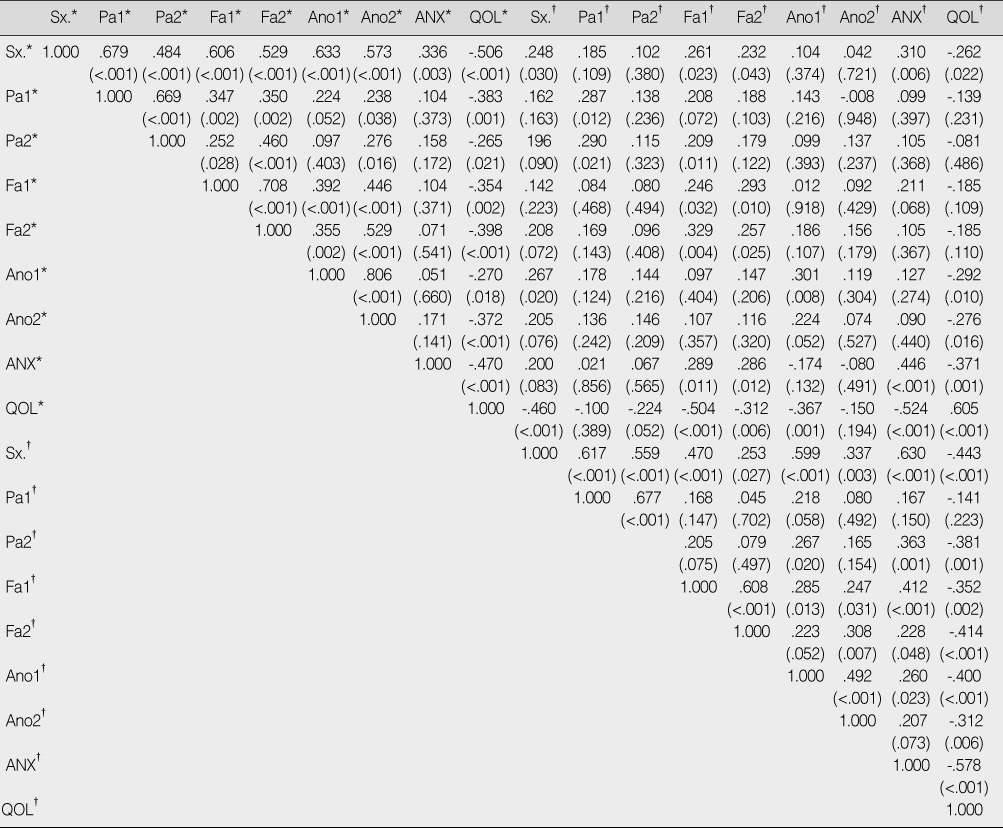
*Before chemotherapy; †After 2 cycles chemotherapy.
Sx.=Number of symptoms; Pa1=pain at present; Pa2=most severe pain in past 3 weeks; Fa1=fatigue at present; Fa2=most severe fatigue in past 3 weeks; Ano1=anorexia at present; Ano2=most severe anorexia in past 3 weeks; ANX=anxiety; QOL=quality of life.
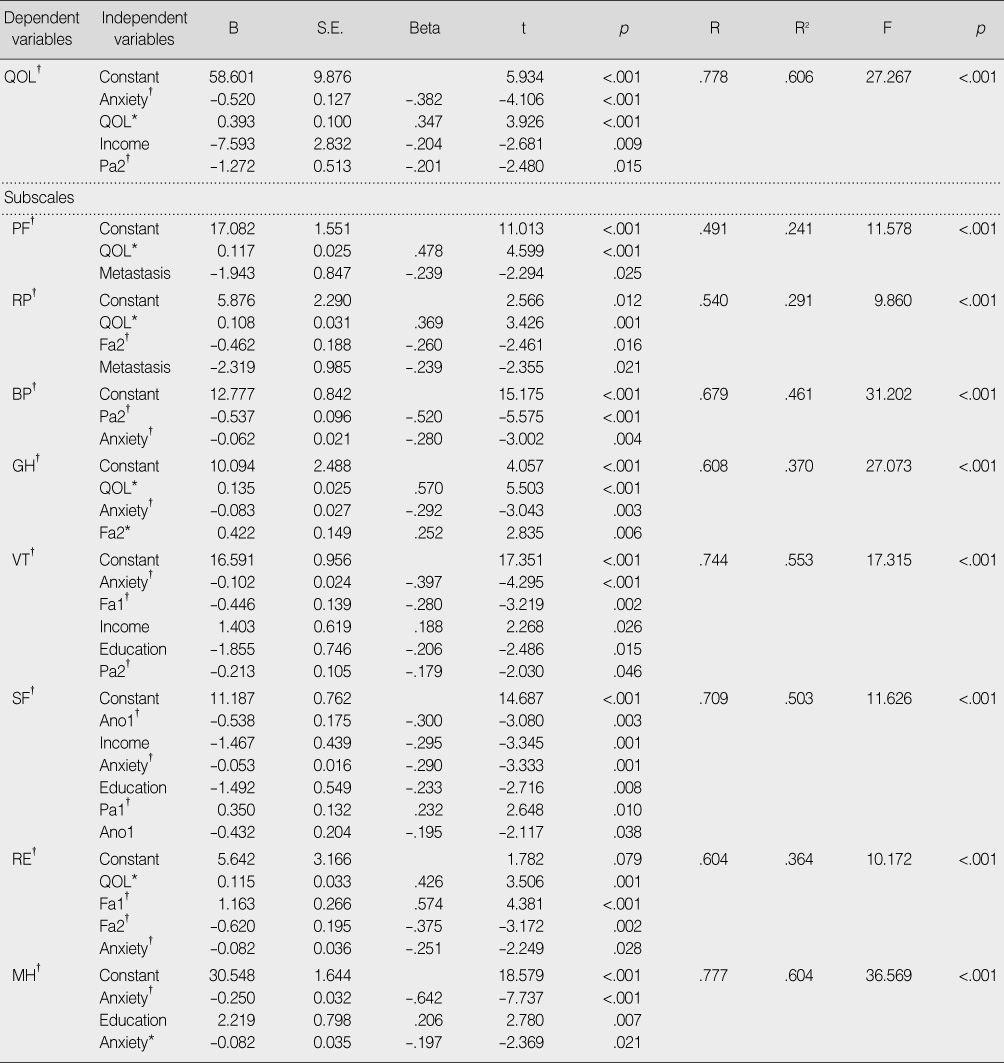
*Before chemotherapy; †After 2 cycles of chemotherapy.
QOL=quality of life; Pa2=most severe pain in past 3 weeks; Fa2=most severe fatigue in past 3 weeks; Fa1=fatigue at present; Ano1=anorexia at present; Pa1=pain at present; PF=physical functioning; RP=role-physical; BP=bodily pain; GH=general health; VT=vitality; SF=social functioning; RE=role-emotional; MH=mental health.
Figure & Data
REFERENCES
Citations

- Analysis of Telephone Counseling of Patients in Chemotherapy Using Text Mining Technique
Seoyeon Kim, Jihyun Jung, Heiyoung Kang, Jeehye Bae, Kayoung Sim, Miyoung Yoo, Eunyoung, E. Suh
Asian Oncology Nursing.2022; 22(1): 46. CrossRef - The Effects of Foot Reflexology on the Physical Symptoms of Cancer Patients
Young-Ran Yeun, Yi-Sub Kwak, Hye-Young Kim
Exercise Science.2021; 30(1): 8. CrossRef - The “Ick” Factor: An Unrecognized Affective Predictor of Physical Symptoms During Chemotherapy
Vinayak Dev, Nathan S Consedine, Lisa M Reynolds
Annals of Behavioral Medicine.2021; 55(4): 345. CrossRef - Factors Related to Smoking Recurrence within Six-months Smoking Cessation among Employees in Enterprises with Smaller than 300 Workers
Byung Jun Jin, Chul-Woung Kim, Seung Eun Lee, Hyo-Bin Im, Tae-Yong Lee
Journal of Korean Academy of Community Health Nursing.2021; 32(1): 107. CrossRef - Review of Clinical Study over the Last 10 Years on Korean Medicine Treatment for Cancer: Focusing on Korean Database
Ji-Won Choi, Yeon-Kyeong Nam, Jung-Han Lee, Hyeon-Jun Woo
Journal of Korean Medicine Rehabilitation.2021; 31(4): 75. CrossRef - Factors Related to Utilization of Smoking Cessation Support Service among Attempters for Quitting Smoking
Hyun-Woo Kim
Journal of Health Informatics and Statistics.2020; 45(4): 349. CrossRef - Factors Affecting Sleep Disturbances in Hospitalized Patients with Colorectal Cancer undergoing Chemotherapy: A Retrospective Study
Jihyeon Song, Smi Choi-kwon
Korean Journal of Adult Nursing.2019; 31(1): 100. CrossRef - Factors associated with the satisfaction of smoking cessation programs in clinics among Korean military personnel: An application of Transtheoretical model
Eunjoo Kwon, Eun-Hee Nah
Korean Journal of Health Education and Promotion.2019; 36(5): 1. CrossRef - A Longitudinal Path Analysis of Symptom, Fatigue and Quality of life in Patients with Colorectal Cancer during Chemotherapy
Eun Hee Kim, Soon Rim Suh
Journal of Health Informatics and Statistics.2018; 43(3): 200. CrossRef - The Effect of Visual Information Blocking Nursing Intervention on Stress and Anxiety during Chemoport Insertion in Adult Cancer Patients of Operation Rooms
Mimi Lee, Wanju Park
Korean Journal of Adult Nursing.2018; 30(2): 194. CrossRef - The study on developing the self care tool for the elderly cancer patient undergoing hemotherapy : Focusing on the effect of Health Monitoring Diary
Yeon Ok Lim, Yojin Kim, Hyunsook Yoon, Dae Young Zang, Dae Ro Choi, Kyoungwon Choi
Korean Journal of Health Education and Promotion.2018; 35(2): 73. CrossRef - Effects of Telephone Counseling Support on Distress, Anxiety, Depression, and Adverse Events in Cancer Patients Receiving Chemotherapy
Oh Nam Ok, Min Sun Nam, Mi Sun Yi, Seon Mi Cho, Eun Ji Kim, Yun Hee Ham, In Gak Kwon
Asian Oncology Nursing.2017; 17(1): 37. CrossRef - Discomfort related to Peripherally Inserted Central Catheters in Cancer Patient
Misun Yi, Im-Ryung Kim, Eun-Kyung Choi, Seyoung Lee, Mikyong Kwak, Juhee Cho, Jin Seok Ahn, In Gak Kwon
Asian Oncology Nursing.2017; 17(4): 229. CrossRef - A prospective exploration of symptom burden clusters in women with breast cancer during chemotherapy treatment
Maria Browall, Yvonne Brandberg, Salmir Nasic, Per Rydberg, Jonas Bergh, Andreas Rydén, Hanjing Xie, Irene Eriksson, Yvonne Wengström
Supportive Care in Cancer.2017; 25(5): 1423. CrossRef - Quality of life changes during adjuvant chemotherapy in patients with colon cancer
Seo Hee Lee, Taek-Gu Lee, Moo Jun Baek, Jang Jin Kim, Sung-Su Park, Sang-Jeon Lee
Korean Journal of Clinical Oncology.2016; 12(1): 60. CrossRef - Symptom clusters of ovarian cancer patients undergoing chemotherapy, and their emotional status and quality of life
Kyung-Hye Hwang, Ok-Hee Cho, Yang-Sook Yoo
European Journal of Oncology Nursing.2016; 21: 215. CrossRef - Factors Influencing Quality of Life during Chemotherapy for Colorectal Cancer Patients in South Korea
Yongae Baek, Myungsun Yi
Journal of Korean Academy of Nursing.2015; 45(4): 604. CrossRef - Factors Influencing the quality of life in thyroid cancer patients after thyroidectomy
Jeong-Sook Jeong, In-Sook Kim, Eun-Seon Lee
Journal of the Korea Academia-Industrial cooperation Society.2015; 16(8): 5442. CrossRef - Changes of Symptom Distress and Quality of Life in Breast Cancer Patients Receiving Adjuvant Therapy
Jin-Hee Park, Sun Hyoung Bae, Young-Mi Jung
Asian Oncology Nursing.2015; 15(2): 67. CrossRef - Impact of Bowel Function, Anxiety and Depression on Quality of Life in Patients with Sphincter-preserving Resection for Rectal Cancer
Hyun Jun Kwoun, Yun Hee Shin
Journal of Korean Academy of Nursing.2015; 45(5): 733. CrossRef - The Effects of a Smoking Cessation Program on Stress and Emotional Status of the Korean Male Office Workers
Mi-Young Yang, Kyung-Min Ahn, Aeree Sohn
Journal of the Korea Academia-Industrial cooperation Society.2013; 14(12): 6364. CrossRef - Anxiety, Depression and Uncertainty in Cancer Patients Participating in Clinical Trial of Anticancer Drugs
Haejin Kim, Myungsun Yi
Korean Journal of Adult Nursing.2013; 25(1): 53. CrossRef - Effects of Foot Massage and Supportive Communication by Hospice Volunteers on Depression, Anxiety, and Mood of Cancer Patients Who Undergo Intravenous Chemotherapy at Out-patient Department
Hea Kung Hur, Hee Young Song
The Korean Journal of Hospice and Palliative Care.2010; 13(4): 232. CrossRef
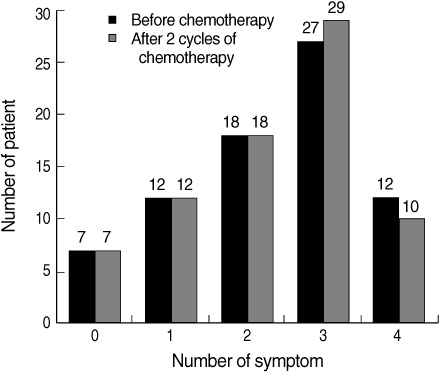
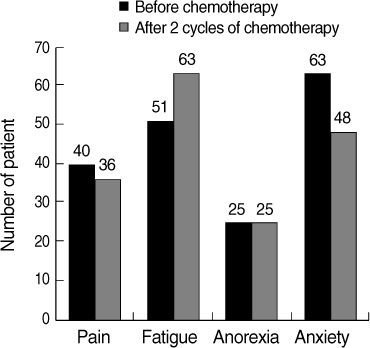
Figure 1
Figure 2
Demographic and Medical Characteristics of Participants (N=76)
AGC=advanced gastric cancer; OP=operation; RT=radiation therapy.
Changes in Pain, Fatigue, Anorexia, Anxiety and QOL (N=76)
*Z by Wilcoxon test.
QOL=quality of life.
Symptom Clustering and Symptom Experience by General and Medical Characteristics (N=76)
Number of Symptom Experience by General and Medical characteristics (N=76)
*Z by Mann-Whitney test; †χ2 by Kruskal-Wallis test.
AGC=advanced gastric cancer; Ca.=cancer.
Correlation between Number of Symptom, Each symptom and QOL
*Before chemotherapy; †After 2 cycles chemotherapy.
Sx.=Number of symptoms; Pa1=pain at present; Pa2=most severe pain in past 3 weeks; Fa1=fatigue at present; Fa2=most severe fatigue in past 3 weeks; Ano1=anorexia at present; Ano2=most severe anorexia in past 3 weeks; ANX=anxiety; QOL=quality of life.
Predictors for QOL and its Subscales After Chemotherapy
*Before chemotherapy; †After 2 cycles of chemotherapy.
QOL=quality of life; Pa2=most severe pain in past 3 weeks; Fa2=most severe fatigue in past 3 weeks; Fa1=fatigue at present; Ano1=anorexia at present; Pa1=pain at present; PF=physical functioning; RP=role-physical; BP=bodily pain; GH=general health; VT=vitality; SF=social functioning; RE=role-emotional; MH=mental health.
AGC=advanced gastric cancer; OP=operation; RT=radiation therapy.
*Z by Wilcoxon test. QOL=quality of life.
*Z by Mann-Whitney test; †χ2 by Kruskal-Wallis test. AGC=advanced gastric cancer; Ca.=cancer.
*Before chemotherapy; †After 2 cycles chemotherapy. Sx.=Number of symptoms; Pa1=pain at present; Pa2=most severe pain in past 3 weeks; Fa1=fatigue at present; Fa2=most severe fatigue in past 3 weeks; Ano1=anorexia at present; Ano2=most severe anorexia in past 3 weeks; ANX=anxiety; QOL=quality of life.
*Before chemotherapy; †After 2 cycles of chemotherapy. QOL=quality of life; Pa2=most severe pain in past 3 weeks; Fa2=most severe fatigue in past 3 weeks; Fa1=fatigue at present; Ano1=anorexia at present; Pa1=pain at present; PF=physical functioning; RP=role-physical; BP=bodily pain; GH=general health; VT=vitality; SF=social functioning; RE=role-emotional; MH=mental health.
 KSNS
KSNS
 E-SUBMISSION
E-SUBMISSION


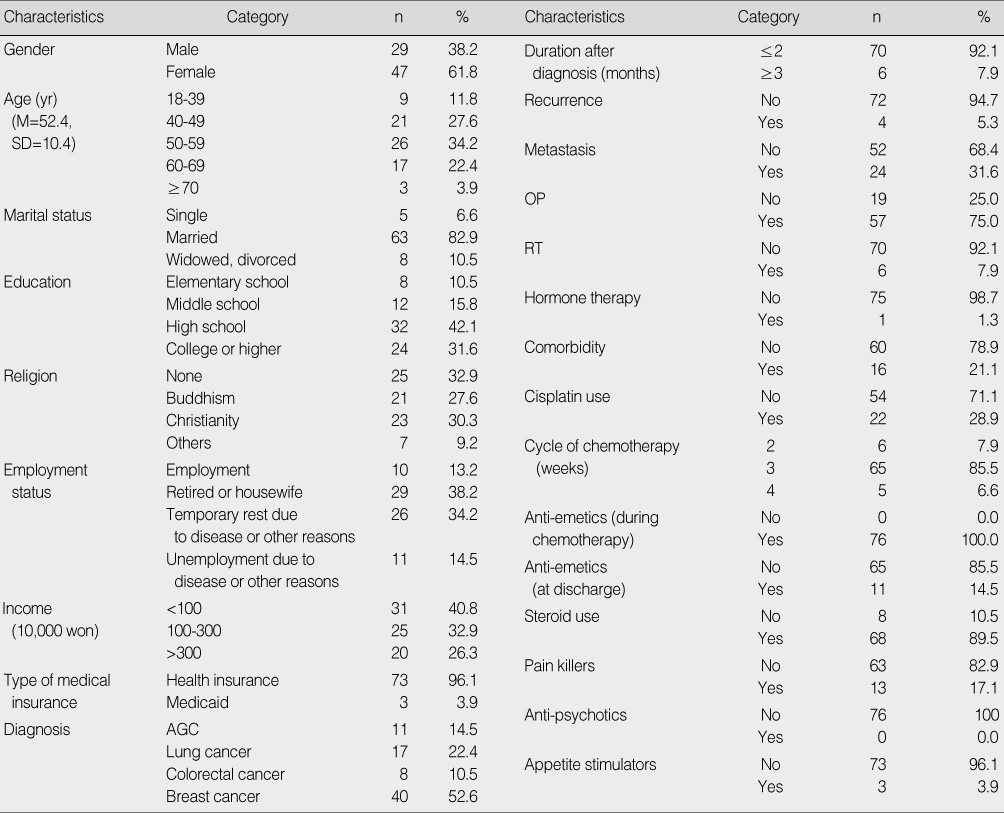

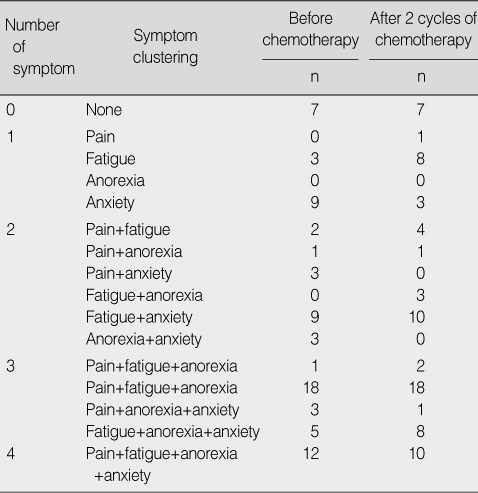
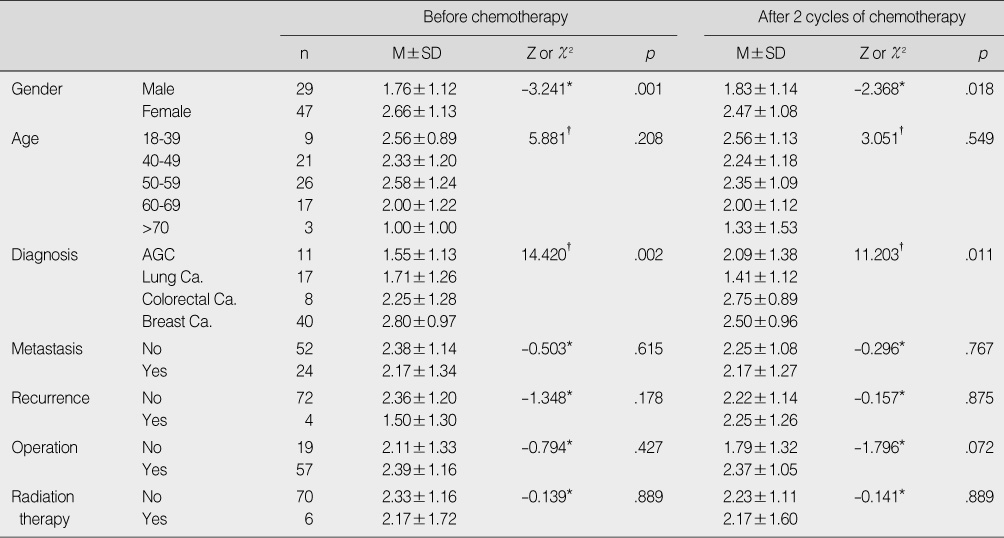
 Cite
Cite

